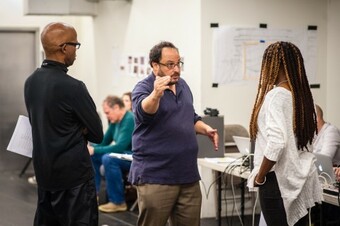Interview with Tory Bailey
Tory Bailey: I’m the Second Director of Theatre Development Fund in New York City. People might say, “Why is TDF at a NewPlay convening?” We’re here first and foremost because we did a project over a period of four or five years called Outrageous Fortune, which was a study examining issues relating to the life and livelihood of American playwrights that Todd London wrote with Ben Pesner. The other thing I think is important in this conversation about new plays and the ecosystem of new plays right now is that there has to be something to do with the audiences. That’s a big part of what we’re all about.
Anthony Werner: Great. So we’re in the middle of the conference now, what have you heard that you can’t stop thinking about?
Tory: I don’t know if there’s just one thing I’ve heard that I can’t stop thinking about. There are two or three things that I’m thinking about. One of them is it’s been an incredibly engaging group of people to be working with and I’m thinking about the fact that people do a lot of very different things. There are presenters here, there are artists, producers, there are a people who have done a variety of things and melded from one to the other, and it’s really interesting and fun to have this thing in the center that everybody’s thinking about. So that’s the first thing, which you don’t always get at conferences.
I’ve been thinking about what happens when you bring energy to a certain kind of thing. Maybe it has to do with the fact that we are sitting in a room and there are people in the middle and we’re listening and there are all these other people who are listening from other places, but I feel there’s a focus, if you will. There’s been some conversation about if we’re preaching to the choir. Maybe. But the people who are here are committed to addressing these issues, and that’s working.
The question is, though, what are we going to do when we leave. The question is how do we keep this going? And there’s also been such tremendous work that has happened here at the Institute. We were prepared for what we came here to talk about. There were convenings on each of these issues, so we were prepared, which makes for a much smarter, informed conversation. Which makes me think how often are we not giving ourselves the opportunity to have these conversations?
Anthony: Where every one’s prepped and ready to go.
Tory: Right. Where you’ve done your homework. Then of course, there’s the space. We’re in this beautiful, marvelous glass cocoon and it’s snowing outside, so it’s not like you can leave or go anywhere. So I’m thinking about energy. I’m thinking about how you put different people together. Today, I had this whole realization about presenters. What are presenters and what are producers and that sounds really facile, but actually it’s not. What are the verbs to produce and to present in the context of success? Why does it work better for devised work to be presented? Then I’m thinking about presenters’ relationship with their audience. What do presenters have to teach me about how they talk to their audience? So that’s what’s in my mind.

Our playwrights are supposed to speak to the larger culture, and the larger culture needs a chance to hear those new voices... There’s scarcity at the largest level. There’s an abundance of production. But is there new play production, or even aesthetically new theatrical production?...No.
Anthony: Which is a lot to think about. The name of the Convening is “From Scarcity to Abundance.” Is the state of the new play sector in a period of scarcity or abundance?
Tory: My answer is both. Maybe there’s a continuum. I’m really troubled by the disconnects between. There’s an awful lot of abundance, in terms of people who care, people who are making resources available for new plays, people who understand the development trajectory, people who are trying not to own any one piece. I’ve spent more time in my life dealing with big and small. I was twenty years at a big institution, or an institution that became big over time, and we have to get some of that small institution mindset, the “what can we do, how do we help you move it forward without owning it” into those larger institutions. I say that not because large is good. I say that for two reasons: one is, face it, when you work in the bigger places you make more money, and money is good and we need to make more money. So there’s abundance up to a certain point. But is there abundance with respect to new plays at those places where those artists can make more? I don’t think so.
The second thing that’s equally important: I’m one of those people who thinks if you do work, lots of people should hear about it. I was challenged at one of the round tables about Outrageous Fortune by a playwright who said, “I’m happy when I do a play and it runs and it’s in a small venue and it’s successful and it was the right audience and five hundred people saw it.” Great. Good. But if our playwrights are supposed to speak to the larger culture, and the larger culture needs a chance to hear those new voices, then what the hell are we doing? There’s scarcity at the largest level. There’s an abundance of production. But is there new play production, or even aesthetically new theatrical production? Is there a real diversifying of the people on stage, off the stage? No. How do you crack that ceiling? And it’s not a glass ceiling. It’s a something. It’s hard for me because I can hear a thousand voices saying, “But I have to think about this, and I have to think about this, and I have to think about this.” It’s all true and totally appropriate, but this energy has not yet been communicated all the way up and down the ecosystem in an effective way.
Anthony: There’s been a lot of talk about the individual artist this weekend and the institution. What can we learn from artists?
Tory: Today we were talking about partnerships, and what’s the difference between partnerships and co-productions. It seems like the more entities that come to the table when you’re talking about producing between two big theaters, or two established theatres, one of the last persons that gets spoken to—I kept hearing this—is the playwright. There’s the theatre’s schedule, the director’s schedule, the company’s schedule, but the smaller institutions, which are more nimble, because they’re smaller, they’re not forgetting to put the artist in the middle. That’s one of the good things about the organized networks, like National New Play Network. It’s a series of theatres that are intentionally saying we’re going to do these sequentially. We’re part of a thing that goes together, but we’re not doing it together, so each of us is allowed to continue to work with that writer the way we’re trained to, which is to say, what do you need?
And I think one of the things that happens is it gets bigger. It’s harder to remember that because you’re also dealing with seven other things that you need. I think we don’t do a good job of explaining to the artists what their concerns are and how it works and what costs money and what doesn’t cost money, so there are still artists that don’t understand things that are presented to them as givens. We think, of course they would know but they don’t. So I think everybody needs to do a better job of saying this is what I need for this piece and my work right now and this is the kind of environment and this is the kind of audience. The same thing goes for theatres. They shouldn’t be scared to say this is what we need right now. We don’t have this. We have to figure out another way to solve this production problem that doesn’t cost money. Not because we’re greedy, but because we don’t have the money and we still want to do it.
Anthony: Speaking to a greater transparency.
Tory: Well, transparency is dangerous. Another interesting thing I heard, was that some of the folks, when they’re presenting, are like, I don’t need to know all the money you bring to the table. I’m going to present you. I don’t want a piece of it. You do your work, you bring it and here’s what I’m putting in. Education and transparency are not the same thing, so where do your needs meet?
I think that when you talk about what you need, there’s so much vulnerability on both sides. But there’s so much vulnerability and loneliness often to be a playwright, which is one of the attractions of ensemble work and devised work—that it’s not so lonely all the time. So to say what I need, to be able to have an honest conversation that this is what I need without being afraid that I’m going to need too much. How are you honest without being vulnerable? and how are you honest without feeling like honesty could slam a door on you? That’s not what this is about, but you hear little ripples.
Anthony: About revealing too much?
Tory: About revealing too much. Yeah. Where it’s working is when people who are saying we’ll produce you or we’ll give you a workshop or we’ll give you space or whatever, it doesn’t matter how much you reveal. They’ll hear it. They’ll care. And there’s an attitude of every project is different, and if every project is different, you listen differently because you’re prepared to hear that they need something no one has needed before. That’s part of what excites you. What does this project need? As opposed to, “Okay, so this is going in this space and this is what they get, and this is…” No, this is not how it happens. You can’t have that. Instead you hear about work that’s different and people that view every project separately as a producer or as the enabler, or whatever that is. If they view every project separately, they’re going to listen more and be careful. Maybe.
Anthony: So the next fifty years, what’s your dream for the American theatre?
Tory: Well, I go back to what I think about every day, which is that I don’t think theatre is ever going to die. I think we’ll always have theatre, but I think we run a very serious risk that it will become increasingly irrelevant to discourse. It will become increasingly irrelevant to most of the people in this country if we don’t figure out how to increase the number of people that are participating. That’s about everything. That’s about diversity, and when I say diversity, I’m not talking just about racial diversity, I’m not talking just about ethnic diversity, or gender, or age. A large percentage of our population is about to hit age sixty-five. But hey, they grew up in the sixties. They’re not dead. They don’t view themselves as old. If we keep talking about our old audience the way we do now, about those folks that are like sixty, we’re going to lose a whole bunch of people who are totally prime still to hear the work. What are we going to do when people are saying, “I don’t want anyone over sixty-five,” and the people they’re saying that to are kissing sixty-five? So my fantasy is that we wake up, we get it, we see what’s coming, because a lot of theaters—and this is not just the commercial theaters, this is all the big guys—either they’re going to wake up and figure out how to communicate differently to a whole lot of people or the model’s going to change because the doors will close.
So when I look ahead fifty years, the big question is what wins? Is it a combination of what I would call destination, tourist-driven theater? Broadway, which is a mix of juke box musicals and really adventurous stuff that commercial producers care about more deeply. And is it empty big buildings because we never figured out how to get an audience, or do we figure out a way that all of this good stuff grows, expands, and is communicated, and how to talk to audiences or non-audiences differently. And how to continue to stir up who’s writing and acting and doing, so that we stay relevant. Sixty years ago, hardly anyone watched television. They figured it out. So let’s figure out how to get back to a place where theatre is important to people. If we don’t, it won’t be my problem. It will be the culture’s problem. That’s a tremendous opportunity and the seedlings are there but I think we’ve got to work fast. The new work is probably the work that most engages those people that are not coming in. As this kind of activity increases, and there are more conversations about reaching out and finding audiences, that there’s much more openness to the idea of finding someone who’s a “nontraditional theatregoer” than there used to be. But you have to figure out how to do that with some scale. That’s what I worry and think and fantasize about. But it could look fabulous. If we do it right, it could look fabulous.












Comments
The article is just the start of the conversation—we want to know what you think about this subject, too! HowlRound is a space for knowledge-sharing, and we welcome spirited, thoughtful, and on-topic dialogue. Find our full comments policy here